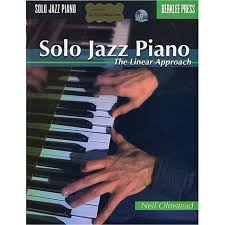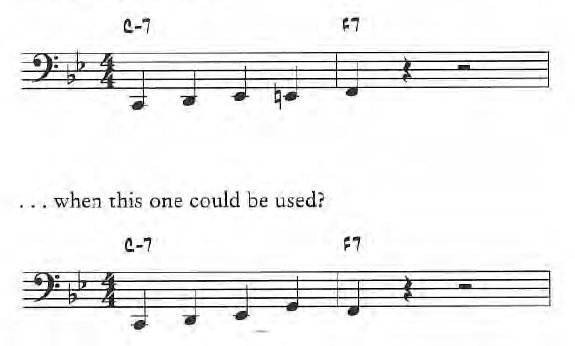Table of Contents
Solo Jazz Piano (Neil Olmstead) with MP3 audio tracks to play along (Berklee Press)

Contents List Download:
Solo Jazz Piano (Neil Olmstead):
Learn to improvise using the techniques pioneered by piano greats Lenny Tristano and Dave McKenna. This methodical approach to learning the art of solo jazz piano improvisation will free your creative sense of music. It beginswith a review of chord symbol interpretation, walks through bass line development, and ends with how to play several melodic lines simultaneously in stimulating musical conversation. You’ll learn how to develop solos thatembellish and support the melody, and use lead sheets to help you generate your own musical ideas. Twenty-one lessons present techniques, practice exercises, and tunes based on jazz standards.
Best Sheet Music download from our Library.
Notated transcriptions of sampleimprovisations illustrate each lesson’s technique, and the accompanying MP3 audio tracks let you hear a master improviser put these ideas to work. Packed with hundreds of ideas that will teach you the art of improvisation!
Please, subscribe to our Library.
If you are already a subscriber, please, check our NEW SCORES’ page every month for new sheet music. THANK YOU!
More about Solo Jazz Piano (Neil Olmstead):
Contrapuntal Jazz Improvisation
Contrapuntal jazz improvisation means improvising simultaneous lines of music within a jazz context. Typically, it is comprised of a bass line in the left hand a.nd either a melody or improvised line in the right band. This can be done within a jazz rune over chord changes or as a pure free-flowing improvisation devoid of speci£c form. In either case, it is a linear texture with wonderful possibilities in all manner of rhythm, harmony, and counterpoint.
History
Lennie Tristano was the groundbreaking pianist of this style with his Descent Into the Maelstrom (1952) and The New Tristano (1962) LPs. The latter recording contains superb performances of Lennie playing jazz standards as well as free-form improvisa
tions. Subsequent recordings include Concert in Copenhagen of 1965 and numerous reissued tracks on various CDs. Lennie’s musical character is rhythmically unique and intellectually complex, and it proved to be a driving force in the development of jazz.
The Boston pianist Dave McKenna could be considered the rhythmic antithesis of Lennie Triscaoo. His solo piano texture is also essentially contrapuntal, but with a more traditional swmg. Many of Dave’s solo and duo recordings conta.in wondeifu1 examples of walking bass lines with deep-swinging, hard-driving right-band improvisations rooted in rhe bebop tradition. McKenna’s solo and duo piano discography is extensive and rooted in tlus tradition of playing.
Other pianists that have recorded in this contrapuntal style include Alan Broadbent, Connie Crothers (both students of Trisrano’s), Tete Momeliu, Kenny Baron, a.nd Diana Krall. More rarely, we also find recordings of Oscar Peterson and Bill Evans playing great bass lines in solo and duo settings.
More evident today is the use of contrapuntal improvisation in ensemble settings. Pianists Brad Melhdau, Ken Werner, and Keith Jarrett are playing clear independent lower lines in the left hand that are set against traditional upper-voice improvised lines.
Appendix B. “Discography” lists some classic recordings in this style, and I encourage you to listen to them while studying these techniques.
The Text
This approach to teaching contrapuntal jazz piano has been refined over many years, teaching hundreds of pianists at Berklee College of Music. Solo jazz Piano codifies this method. Each chapter includes a series of steps that will help develop the language needed to improvise contrapuntally. Left-hand vocabulay, right-hand chords, independence exercises, and ideas on arranging and .improvisation are all described in detail.
Part I reviews chord interpretation.
Part II begins the contrapuntal journey.
Starting with half-nme bass lines, you will develop your sense of rhythmic independence and flexibility, and then move onto more sophisticated walking bass lines. Part III topics include left-hand motivic embellishment, pedal point, multi-voice improvisation, metric modulation, and morivic development.
Though the text touches on h.armony, comping, solo development, and other techniques of improvisation, the focus is on contrapuntal techniques for the solo pianist.
How to Use This Book
Each chapter begins with a discussion of some theory or technique for improvising. These are supponed by practice exercises, such as the ar ow sheets, which will guide you through the thought process of using the technique. The exercises are followed by tunes, which are based on chord progressions of jazz standards. These tuues are presented in two different ways. Etudes are through-composed studies, based on various jazz standards.
Every note is notared, and they serve as complete models for bow the concepts presented earlier can be used. Lead sheets present only the melody and chord changes, and are more representative of what jazz players actually read from. You should create your own bass line, comping part, improvisation, and arrangement to these tunes, agair1, using the techniques and ideas discussed in the chapter. The accompaning CD provides examples of how some of the lead sheets might be interpreted. I encourage you to research the original tunes as well.
The Motives
Bass-line motives (short melodic ideas) are the prime source of vocabulary for the left hand. They originate from frequently used melodic shapes of the jazz tradition. They are not intellectually challenging; they are functional, allowing the bass line to move logically from chord to chord without distracting the performer from his creative right-hand improvisations. These motives should be memorized in much the same manner as you would memorize chord voicings, thereby always having something “in your fingers” to play throughout the harmonic progression of the tune.
When you study these lines, you may wonder, for example, why is this particular motive recommended:

They are boch valid musical ways of getting from the C-7 to the F7 chord. However, the more subtle, less patternistic shape 0£ the first motive is preferred because the line can then be functional without sounding sequential, if the motive is repeated.
Specific methods of developing these motives and creating more diverse and interesting left-hand lines are introduced gradually.
How Piano Bass Lines Differ from Stt·ing Bass Lines
Piano bass lines differ from string bass lines in chat the clariry of the piano tone does not lend itself immediately to all the subtleties of the traditional bass instruments. Consequently, the bass motives discussed in this method are slightly different than those of a bass method. Where a bassist can get away with playing a large number of arpeggios, for example, the arpeggiated bass line on the piano can easily sound overdone and uninteresting) and possibly mote “Chopinesque” than jazz oriented.
The Range
Additionally, the range of the bass line is imponant. The string bass sounds an octave lower than written and has an appropriate tone in almost all octaves. However, the piano bass line can easily sound too high. Hence, I encourage you to play bass lines that are lower than what you may initially feel is natural. This depth of sound is important for the right-hand line as well; the tenor range on the piano will fill in the overtones and significantly enhance the texture when only two voices are sounding. Both Lennie Tristano and Dave McKenna play many of their solos in this low, tenor range, sometimes never reaching the C above middle C.
Necessary Basics
Student of these concepts will gain greater confidence and ease in contrapuntal improvisation if they have:
• the ability to read grand-staff piano scores (see the etudes);
• a basic understanding of jazz chord structure and nomenclature (see chapter 1);
• a general aural concept of bebop piano style (see appendix B);
• a beginning knowledge of the repertoire;
• a functional knowledge of jazz terminology, scales, and modes;
• and most importantly, a strong desire to enhance and explore the contrapuntal possibilities of solo jazz piano technique.
Enjoy this book. I hope that it inspires you to be more creative in your own soloing.
Neil Olmstead – Solo Jazz Piano (The Linear Approach)
About Neil Olmstead
As jazz pianist Neil held a ten-year piano residency at the Copley Plaza Hotel’s Plaza Bar in Boston, sharing the stage with Teddy Wilson, Adam Makovicz, and Dave McKenna, Sammy Price, among others. Neil has performed with The Jimmy Giuffre Quartet, The Moody Blues, Brad Terry and has appeared on NPR’s Eric in the Evening, WGBH-Radio. Neil directs regular concerts of his music in solo duo, and ensemble settings. Performances abroad include the Umbria Jazz Festival in Perugia, Italy and as lecturer/performer at University of Padua, Italy and the Conservatorio Statale di Musica Luisa D’Annunzio in Pescara, Italy.
The compositions include film scores and works for solo piano, prepared piano, voice and piano, small jazz ensemble, big band, and full orchestra. Neil’s orchestral works have been recorded by The Warsaw National Philharmonic Orchestra and the Bratislava Radio and Television Orchestra. His piano and guitar jazz duo recording Colaboração was released in 2012. A recent album Secrets of Ferns is a 5-movement song-cycle for mezzo-soprano and piano.
Neil is author of Solo Jazz Piano, The Linear Approach, sold worldwide and containing original jazz compositions set within a theoretical context. A mainstay of Neil’s professional career has been his 40-year tenure as Professor of Piano at Berklee College of Music in Boston where he has taught private piano, ensemble, composition and solfége. Neil’s professional degrees include Master of Music from New England Conservatory, a Bachelor of Music from Berklee College of Music and undergraduate studies at Boston Conservatory of Music. Neil studied music composition under Dr. Hugo Norden at Boston University, William Thomas McKinley, George Russell, and Nadia Boulanger at Ecole d’Art Americaines, Palais de Fontainebleau, France.
Born in Paris, France, Neil grew up in rural western Massachusetts and now resides in Wayland, outside Boston. In addition to being a husband, father and grandfather he enjoys skiing, sailing and practicing tai chi.
Track List:
1 So Easily 2 Sweet Dolphin Suite 3 A Night At Play 4 Exercise 1. Shifting Time Feels 5 Exercise 2. Shifting Time Feels 6 Cabernet 7 How Deep Is Emotion 8 Winds of Kyle 9 Summer Flight 10 Wild Bill 11 Freezing Fog 12 Evan’s Up 13 Blues Man Soup 14 Dave’s Delight 15 Dark Roast 16 Old Coats 17 Laura Lightly 18 DAO 19 Singularity 20 Jester Play 21 Ultra Violet 22 Exercise 1. Groove Change 23 Exercise 3. Meter and Groove Change 24 Exercise 4. Ballad to 12/8 Feel 25 Exercise 5. Slowing the Tempo 26 Exercise 6. Slowing Then Increasing the Tempo 27 Green Tea 28 Dig Deep
Browse in the Library:
Or browse in the categories menus & download the Library Catalog PDF:
